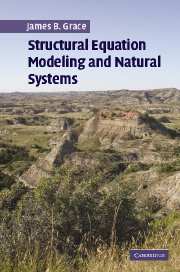Book contents
- Frontmatter
- Contents
- Preface
- Acknowledgments
- PART I A BEGINNING
- PART II BASIC PRINCIPLES OF STRUCTURAL EQUATION MODELING
- PART III ADVANCED TOPICS
- PART IV APPLICATIONS AND ILLUSTRATIONS
- PART V THE IMPLICATIONS OF STRUCTURAL EQUATION MODELING FOR THE STUDY OF NATURAL SYSTEMS
- Appendix I Example analyses
- References
- Index
Appendix I - Example analyses
Published online by Cambridge University Press: 04 December 2009
- Frontmatter
- Contents
- Preface
- Acknowledgments
- PART I A BEGINNING
- PART II BASIC PRINCIPLES OF STRUCTURAL EQUATION MODELING
- PART III ADVANCED TOPICS
- PART IV APPLICATIONS AND ILLUSTRATIONS
- PART V THE IMPLICATIONS OF STRUCTURAL EQUATION MODELING FOR THE STUDY OF NATURAL SYSTEMS
- Appendix I Example analyses
- References
- Index
Summary
Purpose
The purpose of this appendix is to give the reader a little experience with the process of structural equation modeling. I should make the disclaimer that my treatment of the illustrations in this appendix is admittedly superficial. I expect that most readers will forgive this transgression, although some methodological experts may wish that I went into far more detail here rather than assuming that the reader understood all the more subtle nuances from the main chapters of the book. It is beyond the scope of an appendix such as this to give a complete exposition on model evaluation. It is also beyond our scope to give even a superficial overview of the variety of models that can be analyzed using SEM. Our task is further complicated by the significant number of competing software packages, their various features, and the significant issue of how they arrive at the results they yield. Somehow, in spite of all this, it seems useful to provide some illustrations of example analyses, allowing the reader to see some of the steps in the process, some sample output, some of the pitfalls and how they may be avoided or resolved.
It seems that the wisest thing to do in this appendix is to first give an overview of some of the various resources that are available to help the reader towards becoming a competent SEM analyst.
- Type
- Chapter
- Information
- Structural Equation Modeling and Natural Systems , pp. 324 - 349Publisher: Cambridge University PressPrint publication year: 2006
- 3
- Cited by



